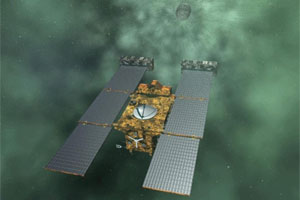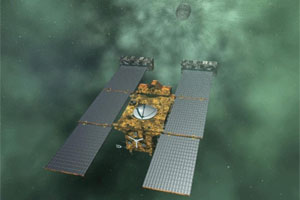 Artist concept of Stardust-NExT approaching comet Tempel 1.
Artist concept of Stardust-NExT approaching comet Tempel 1.
Credit: NASA/JPL-Caltech/LMSS
The human race is certainly leaving its marks on the Solar System. On Valentine's Day, NASA revisited the locale of one of those marks—comet Tempel 1—and far from being a simple "I was here" (like the three scratch marks left behind by Jules Verne's intrepid explorer in Journey to the Center of the Earth), this one was a crater 200 meters across created to see what makes the comet tick….
Cast your mind's eye back five years. Remember NASA's Deep Impact spacecraft, the one that lobbed a heavy metal projectile at Tempel 1 in hopes of seeing what came flying out of the blast, and more excitingly what the hole it made looked like afterward? The idea was to get a better grip on how the comet is put together (is it crunchy, powdery, ice-hard; is it light like Styrofoam, or weightier like block-ice, or concrete?).
Well, as it turned out back in 2006, Deep Impact successfully bullseyed the little 4.5-mile long ice potato—and the impact was so effective that the spectacular blast, as good as anything from the ILM special effects department, completely obscured the spacecraft’s camera-eye view, hiding the would-be crater from sight. The mission was a success, I should add; Deep Impact got plenty of good data and images of the comet and the blast plume—just not the man-made-object-made crater it made….
